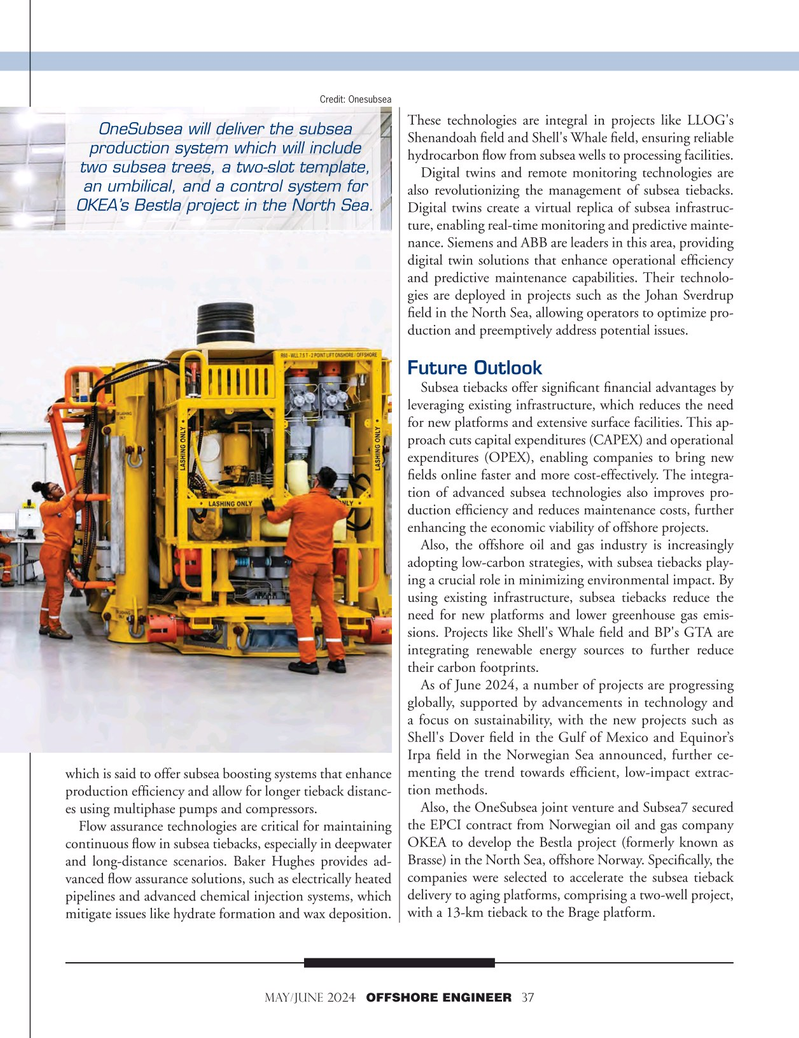
Page 37: of Offshore Engineer Magazine (May/Jun 2024)
Read this page in Pdf, Flash or Html5 edition of May/Jun 2024 Offshore Engineer Magazine
Credit: Onesubsea
These technologies are integral in projects like LLOG's
OneSubsea will deliver the subsea
Shenandoah feld and Shell's Whale feld, ensuring reliable production system which will include hydrocarbon fow from subsea wells to processing facilities.
two subsea trees, a two-slot template,
Digital twins and remote monitoring technologies are an umbilical, and a control system for also revolutionizing the management of subsea tiebacks.
OKEA’s Bestla project in the North Sea.
Digital twins create a virtual replica of subsea infrastruc- ture, enabling real-time monitoring and predictive mainte- nance. Siemens and ABB are leaders in this area, providing digital twin solutions that enhance operational effciency and predictive maintenance capabilities. Their technolo- gies are deployed in projects such as the Johan Sverdrup feld in the North Sea, allowing operators to optimize pro- duction and preemptively address potential issues.
Future Outlook
Subsea tiebacks offer signifcant fnancial advantages by leveraging existing infrastructure, which reduces the need for new platforms and extensive surface facilities. This ap- proach cuts capital expenditures (CAPEX) and operational expenditures (OPEX), enabling companies to bring new felds online faster and more cost-effectively. The integra- tion of advanced subsea technologies also improves pro- duction effciency and reduces maintenance costs, further enhancing the economic viability of offshore projects.
Also, the offshore oil and gas industry is increasingly adopting low-carbon strategies, with subsea tiebacks play- ing a crucial role in minimizing environmental impact. By using existing infrastructure, subsea tiebacks reduce the need for new platforms and lower greenhouse gas emis- sions. Projects like Shell's Whale feld and BP's GTA are integrating renewable energy sources to further reduce their carbon footprints.
As of June 2024, a number of projects are progressing globally, supported by advancements in technology and a focus on sustainability, with the new projects such as
Shell's Dover feld in the Gulf of Mexico and Equinor’s
Irpa feld in the Norwegian Sea announced, further ce- which is said to offer subsea boosting systems that enhance menting the trend towards effcient, low-impact extrac- production effciency and allow for longer tieback distanc- tion methods.
es using multiphase pumps and compressors. Also, the OneSubsea joint venture and Subsea7 secured
Flow assurance technologies are critical for maintaining the EPCI contract from Norwegian oil and gas company continuous fow in subsea tiebacks, especially in deepwater OKEA to develop the Bestla project (formerly known as and long-distance scenarios. Baker Hughes provides ad- Brasse) in the North Sea, offshore Norway. Specifcally, the vanced fow assurance solutions, such as electrically heated companies were selected to accelerate the subsea tieback pipelines and advanced chemical injection systems, which delivery to aging platforms, comprising a two-well project, mitigate issues like hydrate formation and wax deposition. with a 13-km tieback to the Brage platform.
MAy/june 2024 OFFSHORE ENGINEER 37

 36
36

 38
38